Page 6 of 7
Re: Submissions: 2022 August
Posted: Thu Aug 25, 2022 4:38 pm
by bystander
How to edit my previous post? wrote: ↑Thu Aug 25, 2022 3:59 pm
I have just posted my submission regarding a full map and animated rotation of Jupiter, but made the typical mistake in the links...
I would like to edit my post, but cannot find the way.
Guests can't edit posts. You have to be a member.
I corrected it for you.
Re: Submissions: 2022 August
Posted: Thu Aug 25, 2022 5:03 pm
by H-alpha
Guests can't edit posts. You have to be a member.
I corrected it for you.
Thanks a lot bystander!!!

Alexandros
Re: Submissions: 2022 August
Posted: Thu Aug 25, 2022 5:06 pm
by a.carrozzi
The Milky Way from Lama Lite Pass, in the Apennines near Reggio Emilia, emerges from Monte Cipolla, the northern peak of Monte Prado.
Lama Lite, sandwiched between 2 groups of mountains exceeding 2000m above sea level (Cusna to nord and Prado to the south) and with the sparsely inhabited Dolo and Ozola valleys to the east and west, respectively, is able to offer a very dark sky (for those who like measures the sqm is 21.3 mag/arcsec), although light pollution from Tuscany, Liguria and, of course, the Po Valley is unfortunately clearly visible. The brightest star to the left of the Milky Way is actually the planet Saturn, these days in the best visibility conditions of 2022
Technical data: Canon EOS 6D with Samyang 14mm f/2.8 11x25s f/3.5 6400 ISO untracked
 Milky Way from Lama Lite
Milky Way from Lama Lite by
Alessandro Carrozzi, su Flickr
Re: Submissions: 2022 August
Posted: Fri Aug 26, 2022 6:15 am
by logandc99
The Heart of the Eagle Nebula, M16
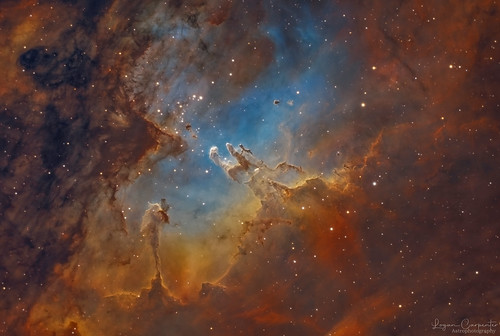 The Eagle Nebula, M16
The Eagle Nebula, M16 by
Logan Carpenter, on Flickr
Integration: 9hrs 30min SHO
Telescope: 10" Meade LX200 ACF SCT with Optec 0.62 focal reducer
Camera: ASI2600mm Pro
Filters: Antlia 3nm SHO
Mount: iOptron CEM120
Location: Auckland, NZ
Date imaged : 23/Aug 2022
Astrobin:
https://www.astrobin.com/full/j81c00/B/?mod=&real=
Re: Submissions: 2022 August
Posted: Fri Aug 26, 2022 6:20 am
by logandc99
The Pillars of Creation in the heart of the Eagle Nebula
Integration: 9hrs 30min SHO
Telescope: 10" Meade LX200 ACF SCT with Optec 0.62 focal reducer
Camera: ASI2600mm Pro
Filters: Antlia 3nm SHO
Mount: iOptron CEM120
Location: Auckland, NZ
Date: 23 Aug 2022
Astrobin:
https://www.astrobin.com/full/j81c00/B/?mod=&real=
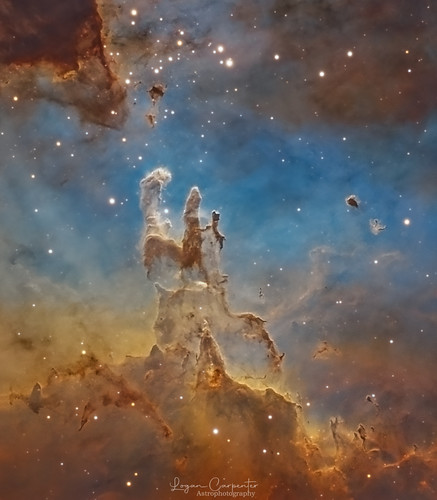 The Pillars of Creation
The Pillars of Creation by
Logan Carpenter, on Flickr
Re: Submissions: 2022 August
Posted: Fri Aug 26, 2022 11:14 am
by Mathieu80
 ETA Carinae_SHO
ETA Carinae_SHO by
Mathieu Guinot, sur Flickr
The colourfull surroundings of Eta Carinae within a 2 panels mosaïc.
I used several Telescope Live data sets with different framing and exposure times that I mixed to get this panorama. The very strong signal at the center of the Carina nebula allows to obtain many color shades in SHO rendering while the focal length used gives access to multiple and fine details, making this area a great pleasure to process, with many rendering possibilities.
The Great Carina Nebula NGC3372 is a large emission nebula located approximately 8,500 light-years away in the constellation Carina. At the center of the nebula, Eta Carinae is a highly luminous hypergiant star, currently the most massive star that can be studied in great detail, because of its location and size. Estimates of its mass range from 100 to 150 times the mass of the Sun and its luminosity is about four million times that of the Sun.
Data acquisition from 2020/11/22 to 2021/05/23 at El Sauce Observatory, Chile.
Telescope : Planewave CDK24
Camera : FLI PL9000 + Astrodon SHO filter set
Exposures : 13h45
Processed with Pixinsight & Photoshop
Re: Submissions: 2022 August
Posted: Fri Aug 26, 2022 3:55 pm
by Paulee97
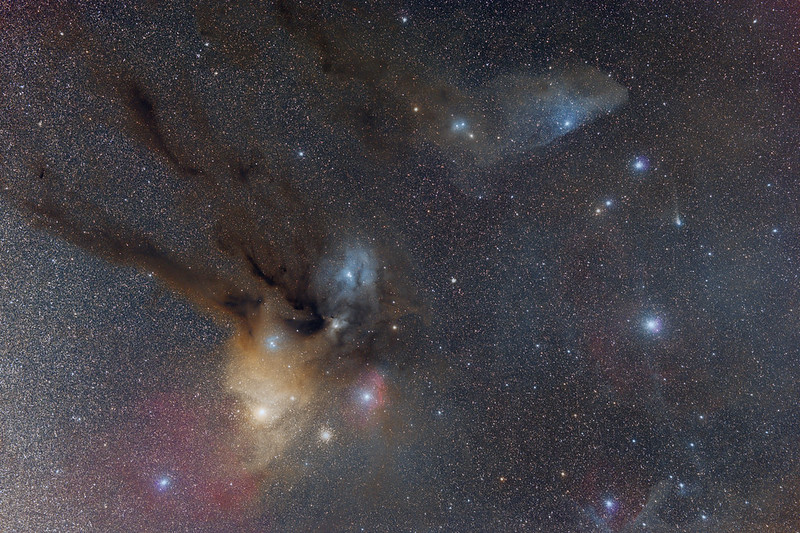 Scorpus region with C/2017 K2 PanSTARRS
Scorpus region with C/2017 K2 PanSTARRS
Author:
Pavel Váňa
Location: Gran Canaria, Spain
A beautiful nigh at Gran Canaria was spent shooting this beautiful region of night sky in Scorpus. Look at the beautiful nebulae around Antares (the brightest star in this constellation) and dark nebulae. At the right upper corner there is blueish nebula called Blue Horsehead nebula.
Technical data: Canon EOS 6D mod., Samyang 135 mm f/2@2.2, ISO 1000. 137 single shots with exposure time 60 seconds were used and stacked. I used Vixen Polarie mount.
Re: Submissions: 2022 August
Posted: Sat Aug 27, 2022 7:53 am
by Daniel Ščerba
Red Spites over Czech Republic 26.8.2022
Red Sprites over storm in northern Bohemia in the Czech Republic on 26.8.2022 at 21:32 CEST. They were taken from Jeseniky Mountains. The distance of the phenomenon is about 200km.
Parameters settings: Sony A7S camera modified + 135GM lens, ISO 2500, F/2, 3,2s + graphic postprocessing.
 https://scontent.fprg5-1.fna.fbcdn.net/ ... e=630E709F
https://www.facebook.com/daniel.scerba/ ... &ref=notif
https://scontent.fprg5-1.fna.fbcdn.net/ ... e=630E709F
https://www.facebook.com/daniel.scerba/ ... &ref=notif
Re: Submissions: 2022 August
Posted: Sat Aug 27, 2022 3:31 pm
by the_astronomy_enthusiast
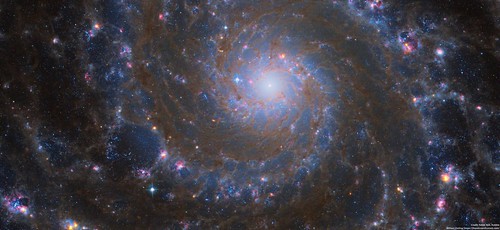 Perfect spiral M74 from JWST and Hubble
Perfect spiral M74 from JWST and Hubble by
William Ostling, on Flickr
Full write-up here:
https://theastroenthusiast.com/perfect- ... nd-hubble/
Processing galactic images with both JWST and HST data is just incredible. Normally, every spiral galaxy (and some elliptical ones too) have dark dust lanes obscuring the light from the stars behind. These dark spirals add depth to the image, but unfortunately don’t contain much information. But with the added infrared imagery, the glowing strands and flocks of dust, which would normally be dark in visible light imagery, are instead bright and glowing with infrared light from JWST.
Website:
https://theastroenthusiast.com/
Instagram:
https://www.instagram.com/the_astronomy_enthusiast/
Re: Submissions: 2022 August
Posted: Sat Aug 27, 2022 5:53 pm
by Ann
That's an amazing, brilliant image and it should be an APOD!


Ann
Re: Submissions: 2022 August
Posted: Sun Aug 28, 2022 3:20 am
by barretosmed
WATCHING THE SKY
BEST DETAILS:
https://www.astrobin.com/full/v5xei8/0/
EQUIPMENT:
Canon 6D
Canon lens 24-105 f4
LOCATION: Munhoz - MG - BRAZIL
DATES: 07/01/2022
Copyright: Fernando Oliveira de Menezes
(Organizing author of the book Amateur Astrophotography in Brazil)
https://clubedeautores.com.br/livro/ast ... -no-brasil
Re: Submissions: 2022 August
Posted: Sun Aug 28, 2022 8:15 am
by Mathieu80
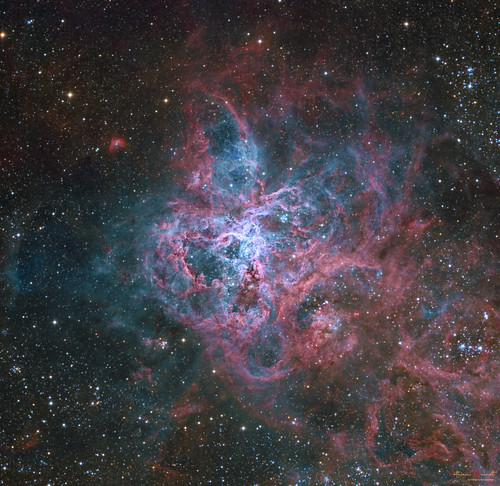 NGC2070_LRGB_HO
NGC2070_LRGB_HO by
Mathieu Guinot, sur Flickr
The famous Tarantula Nebula (also known as 30 Doradus) is a large HII region in the Large Magellanic Cloud (LMC). It is the most active starburst region and also one of the largest HII regions known in the Local Group of galaxies.
At the centre of the Tarantula, NGC 2070 (also known as Caldwell 103) is a large open cluster which produces most of the energy that makes the nebula's gas and dust visible.
I tried pure LRGB processing and SHO processing and finally preferred the rendition of broadband and narrowband combination so i used both data sets (LRGB and SHO) from Telescope Live.
Telescope CDK24
Camera FLI PL9000
Exposure : 18h40
Processing Pixinsight and Photoshop
L : 19×600"
R : 18×300″ + 14×600″
G : 18×300″ + 14×600″
B : 18×300″ + 15×600″
H : 23×300″
O : 23×300″
Re: Submissions: 2022 August
Posted: Sun Aug 28, 2022 9:50 am
by Kinch
SH2-173 (Phantom of the Opera)
Click on above to enlarge.
Full info @
https://www.kinchastro.com/sh2-173.html
Re: Submissions: 2022 August
Posted: Sun Aug 28, 2022 12:15 pm
by Col
Barnard 150 - Seahorse Dark Nebula
Copyright: Colm O'Dwyer

Re: Submissions: 2022 August
Posted: Sun Aug 28, 2022 3:48 pm
by SparkyHT
Wolf-Rayet 134 in HO-RGB.
Imaging Telescope: Sky-Watcher Quattro 250P
Imaging Cameras: ZWO ASI294MM Pro
Mount: Astro-Physics Mach2 GTO
Filters: Chroma Blue 31 mm · Chroma Green 31 mm · Chroma H-alpha 3nm Bandpass 31 mm · Chroma OIII 3nm Bandpass 31 mm · Chroma Red 31 mm
Accessories: TeleVue 2" Paracorr Type-2 (VIP-2010)
Software: Open PHD Guiding project PHD2 · Pleiades Astrophoto PixInsight · Starkeeper.IT Voyager
Frames:
Chroma Blue 31 mm: 15×180″(45′) bin 2×2
Chroma Green 31 mm: 15×180″(45′) bin 2×2
Chroma H-alpha 3nm Bandpass 31 mm: 194×300″(16h 10′) bin 2×2
Chroma OIII 3nm Bandpass 31 mm: 120×300″(10h) bin 2×2
Chroma Red 31 mm: 15×180″(45′) bin 2×2
Integration:
28h 25′
Wolf-Rayet 134 (WR 134) is a variable Wolf-Rayet star located around 6,000 light years away from Earth in the constellation of Cygnus, surrounded by a faint bubble nebula blown by the intense radiation and fast wind from the star. In my image, the Wolf-Rayet star WR 134 is visible in the center of the gas bubble as the brightest white star. Wolf-Rayet stars are extremely hot, bright, massive stars, and one of the rarest classes of stars known. As of 2018, only 154 had been identified in the Milky Way. Some produce spectacular nebula, e.g. the Crescent nebula (NGC 6888), thanks to their strong stellar winds, intense ultraviolet emissions, and clouds of gasses that they shed in earlier stages of their relatively brief lives. Wolf-Rayet nebula around the Wolf-Rayet star WR 134 was first noticed in 1971. The nebula is embedded in the large nebula complex of Sh2-109, so the surrounding area is also filled with lots of emission nebulosity.
Re: Submissions: 2022 August
Posted: Sun Aug 28, 2022 5:05 pm
by a.carrozzi
The famous constellation Cassiopeia is immersed in the Milky Way. This causes its iconic W shape to be virtually unrecognizable in this long-exposure photo taken from the excellent sky of Lama Lite. On the other hand, some emission nebulae with their characteristic red color are clearly visible. From top to bottom: NGC 7822, the Pac-Man nebula and the famous Soul and Heart duo with the Perseus double cluster to their right.
Technical data: Canon EOS 6D modified with Canon 50mm f/1.4 on SkyWatcher Staradventurer 15x120s f/2.8 3200 ISO.
 Cassiopeia and its surroundings
Cassiopeia and its surroundings by
Alessandro Carrozzi, su Flickr
Re: Submissions: 2022 August
Posted: Sun Aug 28, 2022 5:41 pm
by ethanwyh96
Molecular Complex in Corona Australis
https://ewastrophoto.wixsite.com/home/ngc6729
Copyright: Ethan Wong
This was a great target to shoot with a one-shot colour camera: QHY 533C. Even though it was only 90 mins worth of exposure, it was pretty amazing how much duty details it ws able to pull in via my 90mm refractor. Before this, there was a data-loss scare which thankfully did not happen.
Hope you enjoyed it!
Equipment:
QHYCCD 533C
iOptron CEM26
Stellamira CF 90mm triplet
Astronomik L2 UV/IR filter
Imaged in Mersing
https://drive.google.com/file/d/17AtsUy ... sp=sharing
IC410 Tadpole Nebula
Posted: Sun Aug 28, 2022 7:37 pm
by cfm2004
March 2021/April 2022
Location: San Romualdo - Ravenna (Italy)
Tecnosky Apo 130/900 refractor
Avalon M1 - QHY5III 174M on OAG Celestron
CCD QSI 520ws cooled -20
Astrodon RGB GenII I-Series and Narrowband 5nm filters
HA-OIII-RGB: HA 38x10min, OIII 33x10min, R 30x5min, G 26x5min, B 30x5min.
Acquired with: MaximDL5 - Calibrated with Dark, Bias and Flat
Processed with: MaximDL5, Astroart8, Startools 1.8, Photoshop, Paint Shop Pro2022, Topaz and Nik plugin.
Cristina Cellini
Re: Submissions: 2022 August
Posted: Sun Aug 28, 2022 10:42 pm
by Tommy L.
The Bubble Nebula in SHO
Equipment:
ASI533MM-Pro
Astrodon 1.25" 5nm SHO filters
Orion 8" f/4 Newtonian
SW Quattro CC
EQ6R-Pro
Image Details:
Ha- 80x300s, gain 100, -10c
OIII- 40x300s, gain 100, -10c
SII- 40x300s, gain 100, -10c
Total integration: 13 hrs
Acquisition / Edits
Acquired in NINA, Processed in Pixinsight and Photoshop
Re: Submissions: 2022 August
Posted: Mon Aug 29, 2022 7:37 am
by MarT
A narrowband view of sunspot AR3088
The following image was an experiment in which I RGB combined images of the sunspot taken through different narrowband filters. For red I used a H-alpha filter with a passthrough at 656,3nm. For green I used a SolarContinuum filter with a passthrough at 540nm. For blue a UV filter with the maximum passthrough at 380nm was used. Each of the filtered images was a stack of a thousand selected images out of 7000 each.
Credits:
Hvězdárna a planetárium v Hradci Králové / Martin Cholasta / Marek Tušl
Re: Submissions: 2022 August
Posted: Mon Aug 29, 2022 8:16 am
by mathewbrowne
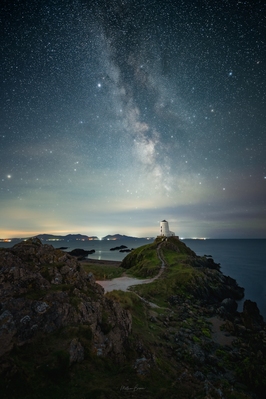
The Milky Way at
Ynys Llanddwyn,
United Kingdom © Mathew Browne via
PhotoHound
Stack of 6 x ISO 3200/20s for the sky and 1 x ISO 400/300s for the foreground
Re: Submissions: 2022 August
Posted: Mon Aug 29, 2022 3:57 pm
by JoeR
M17 Swan Nebula in Sagittarius SHO palette
Celestron C14 & Hyperstar, CGX-L, ASI183MM, Baader 2" HA SII OIII
Copyright: Joe Renzetti
http://www.joerenzetti.com
Re: Submissions: 2022 August
Posted: Tue Aug 30, 2022 1:44 am
by gsanand
NGC 7038 taken with the Hubble Space Telescope's Wide Field Camera 3 (F555W + F814W).
Taken as part of HST GO-16269 (Tension at the Breaking Point: Uncovering New Physics Through a Two-Rung Distance Ladder Measurement of the Hubble Constant, PI: David Jones).
Processing done by me (Drizzlepac+Montage+AplPy+Lightroom).
 NGC7038
NGC7038 by
Gagandeep Anand, on Flickr
Messier 33
Posted: Tue Aug 30, 2022 7:59 am
by alcarreño
Copyrights: Raul Villaverde, Domingo Pestana & Nicolas Romo.
 Messier 33 LRGB_Halfa_2022
Messier 33 LRGB_Halfa_2022 by
Raul Villaverde, en Flickr
Re: Submissions: 2022 August
Posted: Tue Aug 30, 2022 10:39 am
by Mathieu80
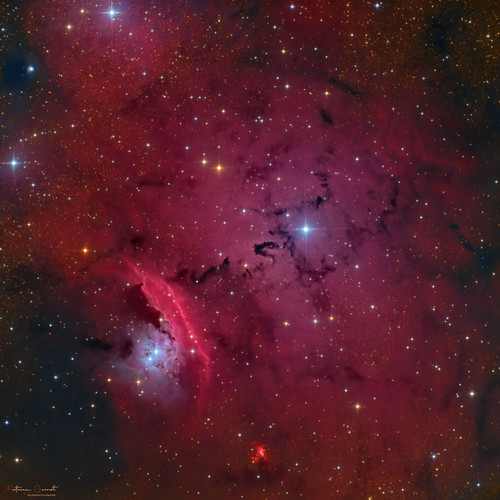 Ngc 6559 & IC 4685
Ngc 6559 & IC 4685 by
Mathieu Guinot, sur Flickr
NGC 6559 (left part of the image) is a star-forming region located about 5000 light-years away in the constellation of Sagittarius, very close to Messier 8 Nebula and showing both emission (red) and reflection (bluish) regions. At the center, the emission nebula IC 4685 is crossed by the dark nebula Barnard 303.
Data grabbed on Telescope Live, taken from 2022/04/29 to 2022/08/14 at El Sauce Observatory, Chile.
Telescope CDK 24
Camera FLI PL9000
Astrodon HARGB filters
Processing is RHa-HaRGB made with Pixinsight & Photoshop
H : 28x600s
R : 28x600s
G : 26x600s
B : 26x600s













